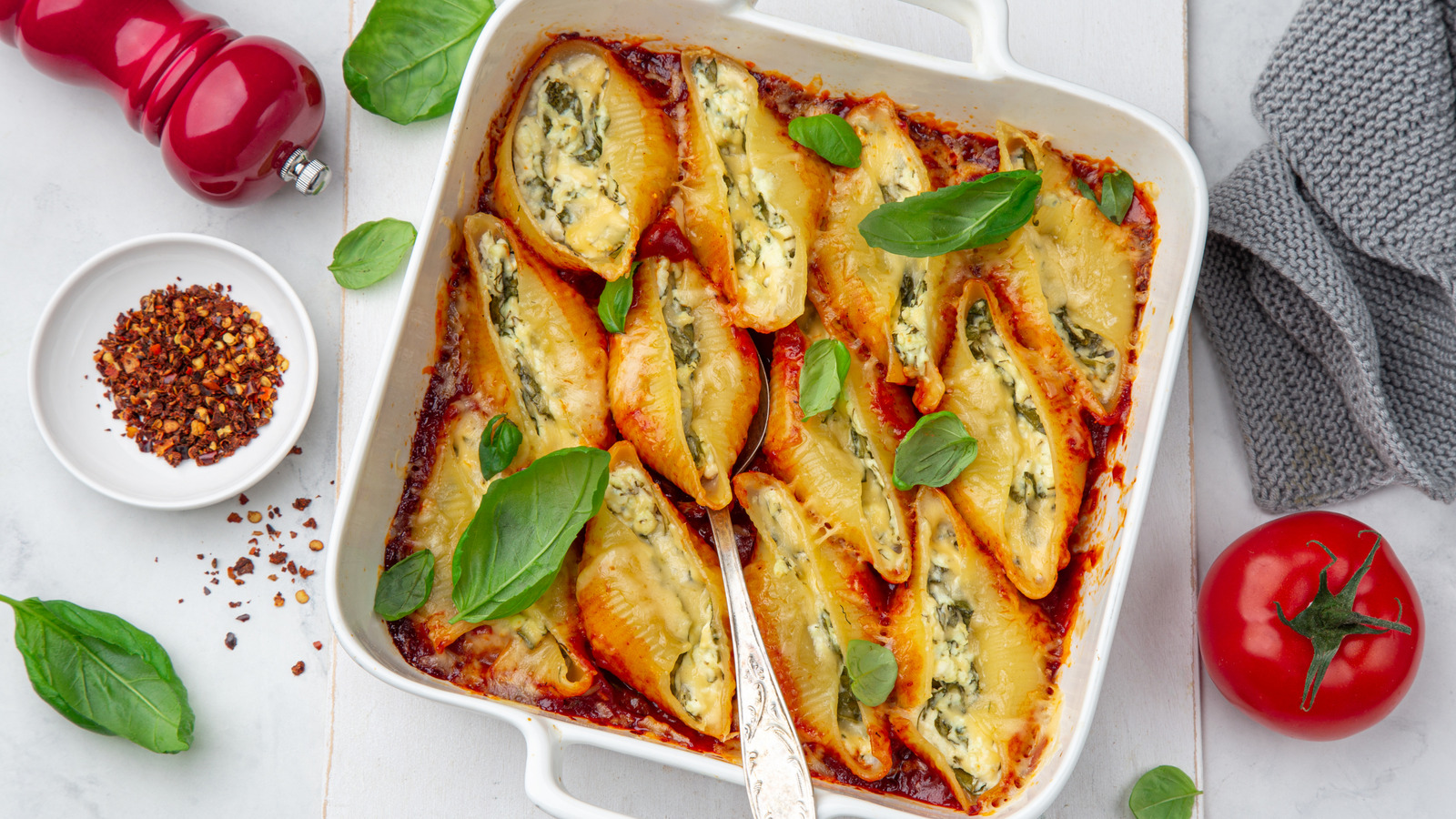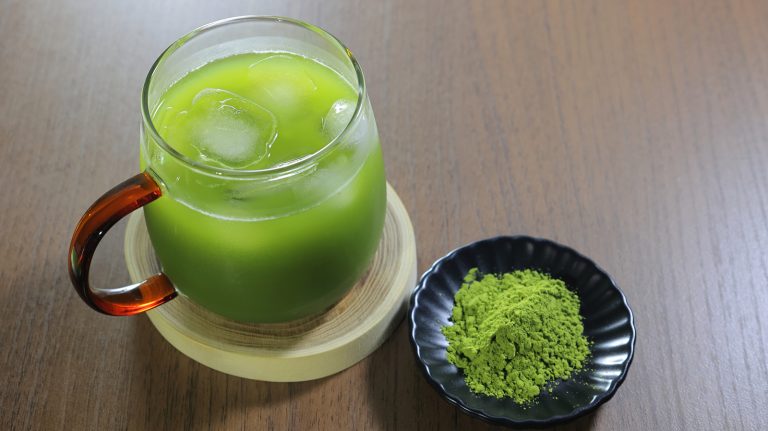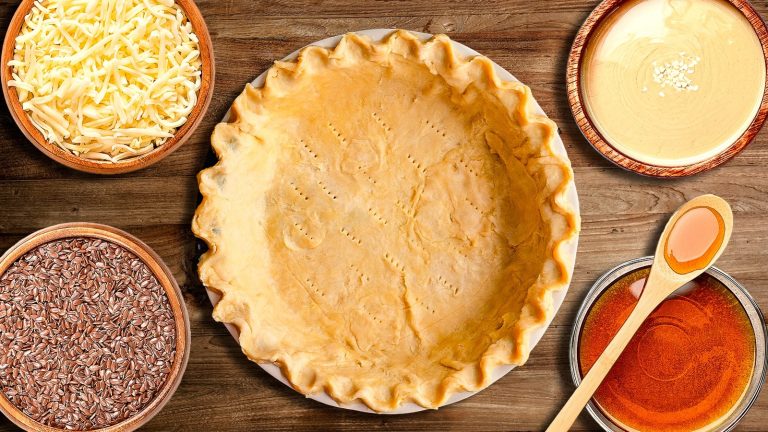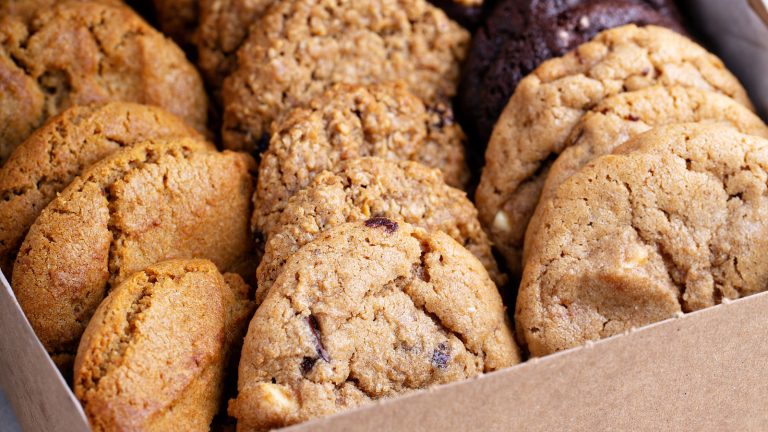There’s nothing quite like a satisfying tray of stuffed shells to ignite your taste buds and keep your belly full. This classic Italian comfort food is relatively easy to make and doesn’t require a lot of specialized ingredients, equipment, or know-how. You might even have everything you need right in your pantry and fridge.
But to get the best results, you still need to follow a few rules when preparing and cooking stuffed shells. Starting with great ingredients is the first step, but as you build the dish, try to avoid making one of these errors to keep your stuffed shells deliciously cheesy and rich.
We talked to Matt Harding, Chief Concept Officer at Piada Italian Street Food; Chef Eric Hammond, Executive Chef at Coco Pazzo; and Chef Joshua Frias at Naples Ristorante e Bar to find out what mistakes have a major impact on stuffed shells. From prep to cooking to serving, here are the top errors that people make (and what to do instead).
Not reading every step of the recipe
Matt Harding stresses the importance of reading through the entire recipe before you get started. If you find yourself doing things out of order, it’s possible that a cluttered recipe is to blame. Jumping right into cooking can mean that you end up adding the sauce before the meat is fully browned or stuffing the shells without adding all of the seasonings into the mixture. “Read and understand the entire method first,” Harding advises.
This is especially important when you’re using an older recipe, since it may have gone through many hands and versions before it ended up in its current state. It’s also key to read through the recipe before you make your shopping list. An ingredient or two may have been left off the list, but mentioned later in the recipe itself. Reading through the recipe is part of your prep work before you even start working with ingredients and cooking.
Messing up measurements
Part of prep work is ensuring that you have the right amount of ingredients, not just the correct ingredients themselves. Preparing things ahead of time can help avoid this mistake, but grabbing the tablespoon instead of the teaspoon can be a catastrophic mistake that is hard to remedy. Depending on how far you are in the cooking process, it can also be difficult to figure out exactly where you went wrong.
It’s best to look closely before you put any ingredient in. Matt Harding follows the “measure twice, cut once” adage, as it applies to the culinary world. “Make sure all your ingredients are measured and clearly portioned,” he says. “Keep them uncluttered and easy to grab once you begin cooking.” This way you can avoid mistakes like using too much salt or making your sauce too runny.
Not prepping first
This is a universal tip, but always prep your ingredients before you start cooking and assembling your dish. In the case of stuffed shells, stopping to cut or chop in the middle can mess up the entire dish. “The largest part of almost any recipe is in the preparation of ingredients and getting the food ingredients cut, cleaned, and prepped to make the dish,” says Matt Harding.
Joshua Frias also follows the same steps, known in French culinary tradition as “mise en place.” He gets everything ready from ingredients to tools so that when it’s time to actually stuff the shells, things are all ready to go. He says it allows him to “focus 100% on the shells and streamline the process.”
Using a thin broth
You can use a thin broth for your sauce, but you’ll need to adjust your cooking times, which is why most people prefer to stick with a thicker sauce instead. Overcooked shells are one of the most common mistakes people make, and the broth is often to blame.
“Thinner liquids penetrate more and will overcook shells,” says Matt Harding. “If you are using more of a broth then the shells should be less cooked than if you are using a thicker sauce such as a marinara, alfredo, or spinach sauce.” Adjust the cooking time of the shells before you put them in the broth or sauce rather than after to steer clear of this mistake. Make sure that they are al dente to avoid overcooking.
Not cooking your shells
If you aren’t happy with the texture of your stuffed shells, your pasta might be the reason why. The shells should be cooked first, even though they will later be cooked in the final assembled dish.
“Cook them until just about al dente, then transfer the shells directly into an ice bath to stop the cooking,” says Eric Hammond. “Then, lay them out on an oiled sheet pan so they don’t stick.” This helps the shells cook just enough to get the right texture in your final masterpiece. Precooking the shells is an important part of the prep work. It is one reason why stuffed shells take so long to make, but it’s key to getting the results you want.
Cooking your shells too much
Just like undercooking your shells can cause issues, overcooking them can be just as problematic. If the shells are completely cooked when they’re done in the boiling water, the pasta will end up mushy and overcooked in the final dish. Even though they may not go into a pot of water again, as our experts previously mentioned, even the cooking time in the broth or sauce makes a difference.
Joshua Frias approaches stuffed shells differently than other pasta dishes. “For most recipes you cook your pasta noodles to the perfect al dente, then remove and combine with sauce to serve. Since your shells will go in for a second cooking after being assembled, you need to leave your shells slightly undercooked,” he says. “By doing this they will finish cooking during the final baking leaving you with perfect al dente shells at the finish.”
Plus, Eric Hammond points out that overcooked shells can lead to them “tearing during [the stuffing phase].” For all of these reasons, it’s best for the sake of the entire dish to undercook the shells when boiling and be safe, rather than sorry later.
Using hot shells
Working with hot shells can make stuffing them very tricky. If you move them right from a pot of boiling water into the assembly line, not only will you run the risk of burning your hands, but you can also mess with the stuffing. Many stuffings use cheese that melts quickly and putting it in hot shells will make them start cooking before you even put them in the oven. You may end up with uneven cooking or burnt portions.
Let the shells cool before you start stuffing them or assembling the dish. As Eric Hammond suggests, put them in an ice bath to stop the cooking process quickly and rinse any extra hot water away. This small action can ensure that you have better control of all of your ingredients at every step of the cooking process.
Not drying the shells
When you make your shells, you can stop the cooking process by rinsing them or putting them in an ice bath. But that doesn’t solve the problem of having shells that are too wet to work with properly. They can end up getting mushy, especially if they sit in water for too long. Wet shells can also mean that the stuffing gets runny or slips out while they are in the oven.
“One thing to keep in mind when building your shells is that excess water is something that should be avoided at all costs,” says Joshua Frias. Once the cooked shells cool, dry off any remaining water. Use a fresh paper towel and pat them gently. Be sure to not be too rough, you could end up breaking or tearing the shells. Drying the shells also helps them cool faster.
Using large pieces of cheese
Matt Harding says that the important consideration with cheese piece size is that it has to melt in the allotted cooking time. Really large pieces will not melt completely, and you’ll be left with blobs within the shells that have a different texture and temperature than the rest of the dish. You also want to make sure to use a uniform size so that everything cooks evenly.
Shredded cheeses are excellent additions and melt quickly. Cheeses like ricotta that have a much creamier element will meld perfectly with other ingredients. Mozzarella makes a wonderful cheese to add salty flavor, plus it melts well. If you want to save time, pick up shredded cheese rather than cubes or slices because it will be able to melt and cook without extending the cooking or prep time of the overall dish.
Choosing cheeses that don’t melt well
You can put your own spin on stuffed shells when it comes to the filling, but cheese is a solid staple in baked pasta that’s incorporated into many stuffed shell recipes. Even though you can experiment with different combinations, it’s best to stick with cheeses that melt well. That creates the gooey comfort food that we all know and love.
“Stuffed shells work pretty well with a wide range of cheeses, but you would want to avoid cheeses that don’t hold up well to cooking, or that don’t melt well unless you are trying to create a textural element with them,” says Joshua Frias. He cautions cooks to stay away from oily cheeses — like brie, mascarpone, and goat cheese — since their texture when melted can cause the filling to ooze out of the shells. Cheeses that don’t melt very well — such as feta and panela cheese — will taste like they are undercooked compared to the rest of the ingredients. Mozzarella, ricotta, and a bit of high-quality Parmigiano-Reggiano does the trick perfectly.
Not draining the ricotta
Ricotta cheese — make sure it’s not cottage cheese, as the two are similar, yet very different – is rich and perfect for stuffed shells, but be sure to drain any excess liquid to keep the shells from being too watery in the end. It can form a creamy base for other flavors, but if too much moisture is left in the cheese, the filling will become runny. It might even end up sliding out of the shells entirely.
Simply draining the ricotta makes a big difference. “If not, the whey in the cheese can separate and create a soupy mess,” says Eric Hammond. Pressing it through cheesecloth is another good way to separate the curds of the cheese from any excess whey. You should do this before mixing in other filling ingredients, such as seasonings, other cheeses, meat, and vegetables.
Making the filling at the last minute
Eric Hammond says that he sees some people making the mistake of not letting the filling rest before using it to stuff the shells. While this isn’t a disaster in the final dish, you might not get the same depth of flavor that you will if the ingredients have a little bit of time to sit and meld together. However, if you mix them in a bowl as part of your prep work and let them sit, the seasonings will be able to get thoroughly into each tasty bite.
Hammond recommends prepping the filling as one of the first steps. The flavors will begin to work together before they go in the shells while you get everything else ready. Avoid making a food safety mistake and be sure to store the filling in the refrigerator if it will be resting for any significant length of time.
Cutting corners with sauce
Jarred sauce works just fine for stuffed shells, but make sure that it is high quality and delicious. If you don’t like the sauce, you won’t be happy with the stuffed shells as a result. Some jarred sauces are too thick, while others are too runny. You can fix this by adjusting the sauce before it goes into the stuffed shells. “You may need to add some water if the jarred sauce is to thick, or reduce in a pan before use if the jarred sauce is too watery,” says Joshua Frias.
Eric Hammond also upgrades store-bought sauces by doctoring them up before using them in dishes like stuffed shells. Add fresh herbs, like basil or oregano, for a punch of flavor. Garlic can add a savory element, while a little bit of wine or olive oil are good to bring out depth.
Keeping your sauce cold
Matt Harding prefers working with warm sauce when assembling the shells. He says that cold sauce can cause problems both with the baking time and with the end texture.
“[Don’t start] with cold sauces for deep bakes and fully stuffed shells. The sauce doesn’t need to be hot, but when you pre-make shells and pull it from the refrigerator beforehand, two things have happened,” he explains. “One, the sauce will be very cold, and it will take forever to heat, and two, the pasta has already begun absorbing the sauce, so the pasta will more easily be overcooked.”
Instead, heat your sauce a little bit before you add it to the assembly. You can use a small saucepan or even just pop it in the microwave for the fastest results. It doesn’t need to be piping hot, just a little bit warm throughout.
Adding dry stuffing
The best stuffings are savory and delicious, but dry ingredients won’t be able to meld well or cook thoroughly. Matt Harding says that dry stuffing can “take a nuclear winter to heat through.” The shells will overcook, even while the filling remains undercooked. The result is a stuffed shell dish with bits that are burnt and crunchy with other parts that are too mushy. If you find yourself unsure of the mash up of textures in your dish, a filling that is too dry might be the mistake you’re making.
Fortunately, you can fix this easily. Instead of dry ingredients in your filling, incorporate cooked meat, melting cheeses, and vegetables to get a good mixture of textures and flavors. It’s best not to rely too heavily on just one element, although a ricotta cheese-based filling is very popular. If you’re worried about the filling being too dry, incorporate a little bit of your sauce.
Using raw vegetables
If you’re adding watery vegetables like mushrooms or peppers, two popular ingredients in stuffed shells, make sure to cook them first. If not, you’ll end up with too much water in the shells, which will make the filling runny and lead to the shells overcooking. The result will be a mushy mess rather than a picture-perfect shell. “Avoid watery vegetables like raw zucchini, mushrooms, and peppers in the filling unless they are pre-cooked,” says Eric Hammond. “Otherwise, they release moisture that can make the dish soggy.”
Joshua Frias likes to roast vegetables that have high water contents before using them in stuffed shells. This will help eliminate the problem of extra moisture, although it does add time and extra prep steps. He says it “also adds caramelization and extra flavor to the finished product,” so this hack can not only help you avoid making a big mistake with your shells, it can actually enhance the flavor in the end as well.
Overfilling the shells
If you add too much filling, the entire shell falls apart as it cooks the second time. While the taste remains the same, the result is a mess that can be difficult to eat. “Stuffed shells should be perfect little self-contained pockets of Italian love and flavor,” says Joshua Frias. “When you overfill the shells, you begin to lose any sense of what they are at all, since filling blends with sauce, turning them into something more akin to lasagna than a stuffed shell.”
Aim for underfilling the shells until you get a good feel for it. Use a piping bag for stuffing the pasta shells to get the filling inside the cooked shells easily without tearing them. You can always make a few, pop them in the oven, and see if you need to make adjustments before cooking your larger batch. Runnier fillings will also tend to leak out because they heat as they cook. It might take some trial-and-error to find just the right combination of textures and filling amounts, but the result is worth it.





